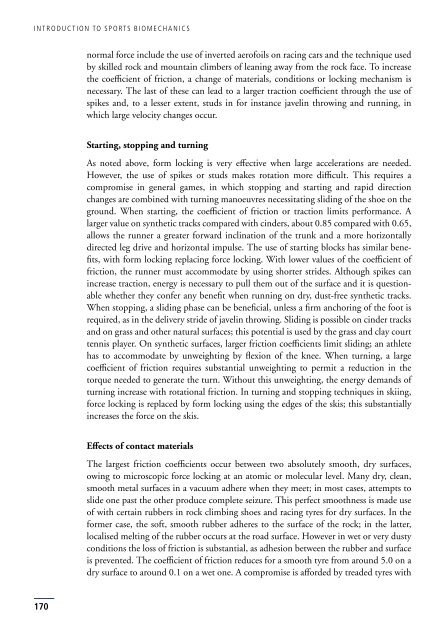Introduction to Sports Biomechanics: Analysing Human Movement ...
Introduction to Sports Biomechanics: Analysing Human Movement ...
Introduction to Sports Biomechanics: Analysing Human Movement ...
Create successful ePaper yourself
Turn your PDF publications into a flip-book with our unique Google optimized e-Paper software.
INTRODUCTION TO SPORTS BIOMECHANICS<br />
170<br />
normal force include the use of inverted aerofoils on racing cars and the technique used<br />
by skilled rock and mountain climbers of leaning away from the rock face. To increase<br />
the coefficient of friction, a change of materials, conditions or locking mechanism is<br />
necessary. The last of these can lead <strong>to</strong> a larger traction coefficient through the use of<br />
spikes and, <strong>to</strong> a lesser extent, studs in for instance javelin throwing and running, in<br />
which large velocity changes occur.<br />
Starting, s<strong>to</strong>pping and turning<br />
As noted above, form locking is very effective when large accelerations are needed.<br />
However, the use of spikes or studs makes rotation more difficult. This requires a<br />
compromise in general games, in which s<strong>to</strong>pping and starting and rapid direction<br />
changes are combined with turning manoeuvres necessitating sliding of the shoe on the<br />
ground. When starting, the coefficient of friction or traction limits performance. A<br />
larger value on synthetic tracks compared with cinders, about 0.85 compared with 0.65,<br />
allows the runner a greater forward inclination of the trunk and a more horizontally<br />
directed leg drive and horizontal impulse. The use of starting blocks has similar benefits,<br />
with form locking replacing force locking. With lower values of the coefficient of<br />
friction, the runner must accommodate by using shorter strides. Although spikes can<br />
increase traction, energy is necessary <strong>to</strong> pull them out of the surface and it is questionable<br />
whether they confer any benefit when running on dry, dust-free synthetic tracks.<br />
When s<strong>to</strong>pping, a sliding phase can be beneficial, unless a firm anchoring of the foot is<br />
required, as in the delivery stride of javelin throwing. Sliding is possible on cinder tracks<br />
and on grass and other natural surfaces; this potential is used by the grass and clay court<br />
tennis player. On synthetic surfaces, larger friction coefficients limit sliding; an athlete<br />
has <strong>to</strong> accommodate by unweighting by flexion of the knee. When turning, a large<br />
coefficient of friction requires substantial unweighting <strong>to</strong> permit a reduction in the<br />
<strong>to</strong>rque needed <strong>to</strong> generate the turn. Without this unweighting, the energy demands of<br />
turning increase with rotational friction. In turning and s<strong>to</strong>pping techniques in skiing,<br />
force locking is replaced by form locking using the edges of the skis; this substantially<br />
increases the force on the skis.<br />
Effects of contact materials<br />
The largest friction coefficients occur between two absolutely smooth, dry surfaces,<br />
owing <strong>to</strong> microscopic force locking at an a<strong>to</strong>mic or molecular level. Many dry, clean,<br />
smooth metal surfaces in a vacuum adhere when they meet; in most cases, attempts <strong>to</strong><br />
slide one past the other produce complete seizure. This perfect smoothness is made use<br />
of with certain rubbers in rock climbing shoes and racing tyres for dry surfaces. In the<br />
former case, the soft, smooth rubber adheres <strong>to</strong> the surface of the rock; in the latter,<br />
localised melting of the rubber occurs at the road surface. However in wet or very dusty<br />
conditions the loss of friction is substantial, as adhesion between the rubber and surface<br />
is prevented. The coefficient of friction reduces for a smooth tyre from around 5.0 on a<br />
dry surface <strong>to</strong> around 0.1 on a wet one. A compromise is afforded by treaded tyres with






